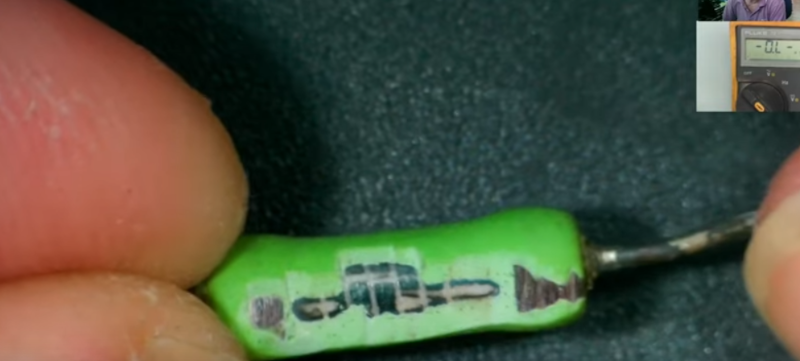You smell smoke and the piece of gear you are working on stops working, probably at an inopportune time. You open it up and immediately see the burned remains of a resistor. You don’t have the schematic, the Internet has nothing to say, and the markings on the resistor are burned away. What do you do? [Learn Electronics Repair] has some advice.
The resistor is probably open, but even if it isn’t, you can’t count on any measurement you make. The burning could easily change the value. The technique comes from comments on one of his earlier videos where he had such a burned resistor but was able to find the correct value. He decided to test the suggestion: cut away the burned resistor and measure the pieces that are left. It probably won’t give you the exact value, but it will get you in the ballpark.
So a rotary tool did the surgery, and you can see it all in the video below. We aren’t sure this method would work on every type of resistor you might encounter, and surface mount will also present special problems. However, if you are stabbing in the dark anyway, it won’t hurt to try.
Everyone knows the smoke that comes out is magic. Sometimes, you cut into components by necessity. Other times, it is for art’s sake.
















Any port in the storm.
Good one Ren.
Any port in a storm.
Great video!
That will not work on a carbon comp resistor, But that is probably showing my age.
Clever though it looks like that technique works only for wirewound larger wattage resistors. I think it might be made to work for carbon comp ones though I suspect you’d need a more stable way to grind the outer covering off. Burnt SMDs, probably not so much. Also, for over heated resistors, the assumption that the heat did not change the resistive nature of the material may not be valid.
There’s definitely an art to figuring out replacement values. Creating a schematic helps a lot. Understanding the basic function of the circuit and general parameters like frequency can get you in the ball park.
Those of you who, like me, have been round the sun far too many times, will probably remember the foot-long (30cm) multi-part wire-wound resistors which were used as a cheap alternative to transformers in the black and white TVs of the time.
When they went open circuit (which was a frequent occurrence), they left a distinct black spot on the outer coating. If you’d already used up your stock of replacement resistors for the day, you simply lifted both ends of the wire out of the coating with a small screwdriver and unwound enough to be able to twist the bare ends together. Instant repair to get the set running until you could get back with the actual replacement.
Field techies of the era would also use the ceramic former from a burnt-out resistor as a cover for their hot soldering iron when putting it back into the tool kit before dashing off to the next job. You wouldn’t want to rest your hand on it, but it would prevent the hot iron from burning or melting the tool case or the other tools.
Recently I checked my SRM 717 energiser fir my Stax. I checked its PSU’s voltage output. Looked not right. I decided to take out some power resistors. Their appearance looked alright but their values changed alot, eg. 4.4 M Ohm became 6.8 M. They varied alot. Also we can’t check caps on site. We’ve to pull it off eventhough we use the on site tester. The value is different.